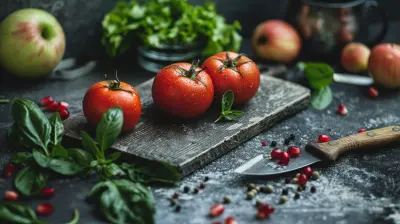How to Navigate a Gluten-Free Lifestyle Without Feeling Overwhelmed
21 January 2025
If you've recently been told to follow a gluten-free lifestyle, your first instinct might be to panic. Relax—you're not alone! Whether you're tackling celiac disease, gluten sensitivity, or just aiming to feel healthier, transitioning to a gluten-free diet can be a game-changer. But let’s face it: it can also feel like you’re stepping into an entirely new world where bread and pasta—the holy grails of comfort food—suddenly turn into your archenemies. Sound about right?
Fear not, my friend. With the right mindset and a handful of practical tips, navigating a gluten-free lifestyle is easier than you think. Ready? Let’s break this down step-by-step so you can tackle this new way of eating like a pro. Spoiler: It's not all doom and gloom.
What Exactly Is Gluten, Anyway?
Ah, gluten. That mischievous little protein found in wheat, barley, and rye that seems to sneak into everything from bagels to soy sauce. Essentially, gluten is responsible for giving bread its chewy texture and helping it rise during baking. It’s like the glue that holds food together—hence the name "gluten."Unfortunately, for some people, gluten acts more like a saboteur. If you have celiac disease, gluten can trigger an autoimmune response that damages your small intestine. For those with non-celiac gluten sensitivity, it can cause bloating, fatigue, and a general feeling of “blah.” Either way, avoiding gluten is a must.
Step 1: Don’t Overthink It—Start Simple
I know, I know. Going gluten-free sounds like a Herculean task, especially when you start reading labels and realize how many foods contain gluten. But here’s the deal: Instead of overloading yourself with information right away, start with the basics.You don’t need to memorize the encyclopedia of gluten-containing foods overnight. Begin by focusing on naturally gluten-free options like:
- Fruits and veggies
- Meat, poultry, and fish (unprocessed)
- Eggs
- Dairy (most of it)
- Rice, quinoa, and other gluten-free grains
Think of this as building the foundation of your gluten-free house. Once you’ve mastered the basics, you can get fancy with gluten-free breads, snacks, and desserts.
Step 2: Learn to Read Labels Like a Detective
Shopping for groceries on a gluten-free diet isn’t as simple as strolling through the aisles and grabbing your usual picks. Oh no. Now, you’ve got to channel your inner Sherlock Holmes and start reading labels like your life depends on it. (Okay, maybe not that intense, but you get the point.)Look out for obvious red flags like "wheat," "barley," and "rye." But beware—gluten has a sneaky side. It often hides under aliases like:
- Malt (from barley)
- Brewer’s yeast
- Durum
- Farro
- Semolina
- Spelt
Also, keep an eye out for cross-contamination warnings, especially if a product is processed in a facility that handles wheat. Stick with certified gluten-free labels to be safe.
Step 3: Stock Your Pantry with Gluten-Free Staples
Picture this: It’s lunchtime, and you suddenly realize your kitchen is a gluten-filled war zone. Bread crumbs on the counter, regular pasta in the pantry, wheat flour lurking in the baking cabinet. Yikes. Time to take control!Declutter your pantry by removing obvious gluten-containing items and replace them with gluten-free alternatives. Some must-haves:
- Gluten-free pasta (made from rice, corn, or chickpeas)
- Gluten-free bread and tortillas
- Almond or coconut flour for baking
- Tamari (a gluten-free soy sauce alternative)
- Gluten-free oats (yes, they need to be certified!)
Having these staples on hand makes mealtime way less stressful. Plus, you won’t be tempted to “cheat” when hunger strikes.
Step 4: Dining Out? Be the King or Queen of Communication
Eating out on a gluten-free diet doesn’t have to feel like navigating a minefield. The key? Communication. Don’t be shy about asking questions or explaining your needs to the staff. Consider these tips:1. Research Restaurants Ahead of Time: Many places now list gluten-free options on their menus, but it’s always a good idea to call ahead and confirm.
2. Be Specific: Instead of saying, “I can’t eat gluten,” explain what that means. Some servers might not realize things like soy sauce or flour-based sauces contain gluten.
3. Avoid Cross-Contamination Risks: Ask how food is prepared—shared fryers or cutting boards can be risky.
4. Bring Your Own: No shame in tossing a gluten-free tortilla or salad dressing into your bag just in case.
Dining out is totally doable; it just requires a little extra planning.
Step 5: Experiment with Gluten-Free Recipes
Once you’ve got your pantry stocked and your restaurant skills sharpened, it’s time to get creative in the kitchen. Instead of mourning the loss of wheat-based goods, think of this as an opportunity to discover new favorites. There are so many amazing gluten-free recipes out there, from cauliflower pizza crust to almond flour pancakes.Need inspiration? Start with these ideas:
- Breakfast: Smoothie bowls, chia seed pudding, or avocado toast on gluten-free bread.
- Lunch: Lettuce wraps, quinoa bowls, or hearty soups.
- Dinner: Zucchini noodles with marinara, roasted chicken and veggies, or stir-fried rice with tamari.
Cooking at home ensures you know exactly what’s going into your food, which is a huge win when you’re avoiding gluten.
Step 6: Build a Support System
Here’s a little secret: You don’t have to go on this gluten-free journey alone. Whether it’s chatting with friends, joining online forums, or following gluten-free bloggers on social media, having a support system makes all the difference.Why not invite friends over for a gluten-free dinner party? Or swap recipes with someone who’s already mastered the lifestyle? Tackling this as part of a community is way more fun (and less overwhelming) than doing it solo.
Step 7: Remember It’s Okay to Mess Up
Let’s keep it real for a minute: You’re going to make mistakes. Maybe you’ll accidentally eat a sauce that contains gluten or grab a snack without checking the label. Guess what? It’s fine. These slip-ups don’t mean you’re failing; they’re part of the learning process.If you do make a mistake and end up feeling crummy, don’t be too hard on yourself. Learn from it and move on. Progress isn’t about being perfect; it’s about being consistent over time.
The Upside: You’ll Feel Amazing
Sure, cutting out gluten might feel like a hassle at first. But here’s the silver lining: Once you’ve adjusted, you’re going to feel so much better. For many people, ditching gluten reduces fatigue, improves digestion, and boosts overall energy levels.Plus, you’ll be eating a more nutrient-dense diet filled with wholesome, naturally gluten-free foods. Who doesn’t want that?
Final Thoughts: Embrace the Journey
Navigating a gluten-free lifestyle might feel overwhelming at first, but let me tell you—it gets easier. Like any big change, it takes time, patience, and a sense of humor. Remember, this isn’t about deprivation; it’s about finding new ways to fuel your body and feel your best.With these tips in your back pocket, you’re well on your way to becoming a gluten-free pro. So take a deep breath, stock up on those staples, and start experimenting. You’ve totally got this!
all images in this post were generated using AI tools
Category:
Gluten FreeAuthor:

Angelo McGillivray
Discussion
rate this article
12 comments
Bear McMahon
Embracing a gluten-free lifestyle is empowering, not daunting. With the right resources and a positive mindset, you can enjoy delicious meals while prioritizing your health. Remember, it's about balance and exploration—discover new flavors and ingredients that enrich your life, not restrict it!
March 25, 2025 at 3:21 AM

Angelo McGillivray
Thank you for your insightful comment! Embracing a gluten-free lifestyle truly opens up a world of new culinary experiences while prioritizing health. It's all about balance and exploration!
Dolores Morrow
Embrace gluten-free living fully; it’s not a limitation, but a vibrant opportunity to explore new flavors!
February 12, 2025 at 5:26 PM

Angelo McGillivray
Thank you! Embracing gluten-free living can indeed open up a world of exciting flavors and culinary creativity!
Teagan McEachern
Embrace the journey; small steps make gluten-free living enjoyable and manageable.
February 6, 2025 at 3:34 AM

Angelo McGillivray
Absolutely! Embracing the journey with small steps is key to enjoying a gluten-free lifestyle. It makes the transition smoother and more fulfilling. Thank you for your insights!
Loretta McConkey
Navigating a gluten-free lifestyle doesn’t have to be daunting. Start by familiarizing yourself with gluten-free grains like quinoa and rice, and explore fresh fruits and vegetables. Meal prepping can simplify your week, while focusing on whole foods will help you feel satisfied and healthy.
February 1, 2025 at 5:22 AM

Angelo McGillivray
Absolutely! Embracing gluten-free can be simple and enjoyable with the right approach. Thanks for highlighting the importance of whole foods and meal prep!
Meredith McCloud
Great tips, thanks so much!
January 27, 2025 at 8:48 AM

Angelo McGillivray
You're welcome! I'm glad you found the tips helpful!
Darby McPherson
Embrace the gluten-free journey with joy! Discover tasty options and simple tips that make healthy living a breeze. You’ve got this!
January 27, 2025 at 4:13 AM

Angelo McGillivray
Thank you! Embracing this journey can be rewarding, and I’m glad you found these tips helpful. Cheers to delicious gluten-free living!
Kalani Cole
Going gluten-free? Embrace the journey with tasty treats and laughter—nothing beats a good gluten-free giggle!
January 27, 2025 at 12:34 AM

Angelo McGillivray
Absolutely! Embracing gluten-free living can be delightful with the right mindset, tasty options, and a sense of humor!
Andrew Ellison
Great tips! Simplicity is key to enjoying a gluten-free lifestyle. Thank you!
January 26, 2025 at 4:00 PM

Angelo McGillivray
Thank you for your feedback! I'm glad you found the tips helpful. Simplicity really does make a difference!
Rocco Cox
Gluten-free: less bread, more cake! 🍰
January 26, 2025 at 5:14 AM

Angelo McGillivray
Absolutely! Embracing gluten-free treats can make the transition enjoyable—just remember to balance it with wholesome options too! 🍰
Gisela Reilly
This article offers practical strategies for adopting a gluten-free lifestyle, emphasizing mindful choices and gradual transitions, ensuring readers feel empowered rather than overwhelmed in their dietary journey.
January 22, 2025 at 5:30 PM

Angelo McGillivray
Thank you for your insightful comment! I'm glad to hear that the article resonates with you and offers practical support for a gluten-free journey.
Nym McCracken
This article offers practical tips that truly resonate. Transitioning to a gluten-free lifestyle can be daunting, but the straightforward advice makes it manageable. I appreciate the focus on balance and enjoyment throughout the journey.
January 22, 2025 at 3:27 AM

Angelo McGillivray
Thank you for your kind words! I'm glad you found the tips helpful and that the focus on balance resonated with you. Enjoy your gluten-free journey!
Michelle Shaffer
Embrace simplicity, focus on whole foods, and find joy in your gluten-free journey.
January 21, 2025 at 3:38 AM

Angelo McGillivray
Thank you for your insight! Embracing simplicity and whole foods is key to enjoying a gluten-free lifestyle.
MORE POSTS

Exploring the Impact of Birth Control on Hormonal Wellness

How to Choose the Right Moisturizer for Your Skin Type

Maximizing Your Workout Routine: Tips for Better Results

Gluten-Free Meal Ideas the Whole Family Will Love

Athletic Performance: The Role of Recovery in Wellness

How to Stay on Track After Reaching Your Weight Loss Goals

Harnessing Emotional Energy and Releasing Tension

The Impact of Stress on Chronic Pain: Coping Strategies